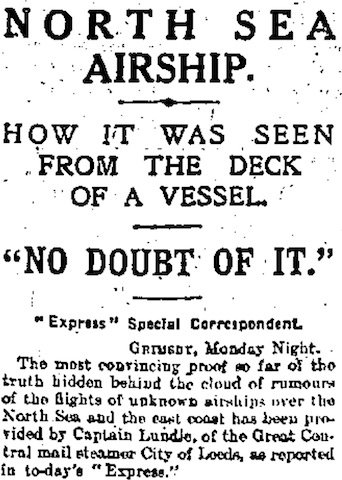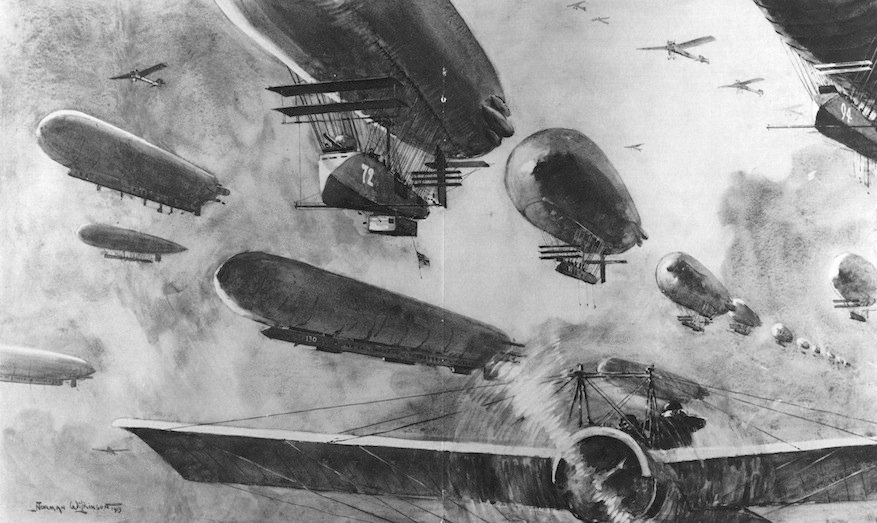
The Dundee Courier today has a long article providing more details of the airship seen by Captain Lundie and the crew the City of Leeds off Grimsby — ‘It was travelling at a fast rate, and somewhat resembled a shark in shape’ (p. 5) — and the Daily Express has an even longer, more reflective piece. Its ‘Special Correspondent’ makes the case that this is ‘The most convincing proof so far of the truth hidden behind the clouds of rumours of the flights of unknown airships over the North Sea and the east coast’ more persuasively than previous attempts, though still hardly conclusively (p. 5; above). Captain Boothby, the assistant marine superintendent at Grimsby who was the recipient of Lundie’s original report, believes ‘that the statement could certainly be confirmed beyond any doubt’:
‘That it was an airship — a cigar-shaped dirigible of large size that Captain Lundie saw, I also am certain,’ continued Captain Boothby. ‘He had ample opportunity for seeing it, and his experience would prevent him mistaking anything else for an airship.
This ‘experience’ appears to be Lundie’s (doubtless many) years at sea; there is no suggestion that he is in any way familiar with airships or aeroplanes. And while other members of the crew did see it — among them Second Officer Williams and the ship’s cook, who describes seeing ‘a dark shape floating by high in the moonlight’ — it is Lundie’s ‘precise, carefully detailed, statement’ alone that represents ‘evidence that can hardly be doubted, and the importance of which, once it is admitted to be true, cannot be easily over-estimated’:
It proves that under all the wild rumours of ‘scareships,’ of practical jokes with fire-balloons, and the tales of untrained or imaginative gazers by night who mistake fiery stars for dirigibles’ ‘flashing searchlights,’ there is a solid foundation for the fears of an airship invasion, which all expert airmen agree will very soon be not only quite possible, but extremely probable.
The Express‘s correspondent spent the weekend touring ‘the Yorkshire coast from Withernsea round the sweep of Bridlington Bay to breezy, hilly Scarborough’ (all places where phantom airships have been seen), ‘the stretch which may be one of the widest “open doors” of England when aerial progress makes Great Britain an island no longer’.
All round the coast and in the great ports of Hull and Grimsby, as well as in the scattered villages and fashionable seaside resorts I have heard stories of the airship, but behind the light jests and the half doubting guise in which the many wildly improbable stories were recounted, there was apparent a feeling that those mysterious airships might be in some cases a reality — a reality to be dreaded and proved against at any cost. The fear that flies by night is over Yorkshire.
The correspondent claims that there is ‘no longer any doubt’ that coastguard stations and lighthouse keepers are ‘acting on some special instructions from the Admiralty and Trinity House’:
Orders have been given since the hurried passing of the new Aerial Law that instant notification must be made of the presence of any airship, British or foreign, and that a detailed description of its movements shall be telegraphed along the coast defence wires, which form a private and independent service.
The coastguards at Hornsea who saw an airship last Tuesday made their report to the Admiralty under this ‘official order’. The Express‘s correspondent is impressed by the seriousness and devotion of the men of the ‘special “war” coastguard station‘ on Flamborough Head: ‘All the time I watched him he did not put down his glass, but silently swept the sky line’.
These are the trifles showing that the airship peril is a real, and not an imaginary one, which I have seen for myself, and out of the score or so of people I have talked with who say they have seen the airship, only half a dozen perhaps, and these chiefly from the village of Hornsea or from the steamer City of Leeds […] have produced any probable proof that they have seen an airship. It is enough. They have certainly made out a case in support of their belief, which cannot be explained away by any theories of blazing planets, stars, or oil-soaked paper bags flying in the air. But if only one person, and that one the trained observer, Captain Lundie, had actually seen the airship, the danger of an aerial invasion would be just as serious as it is.
As for the origin of the airship, Captain Boothby professes to have an open mind:
‘It is impossible to say, of course, whether this airship is of foreign design or whether it is a British airship with which secret experiments are being made from the security of some Yorkshire valley. It is even possible that it is an attempt on our part to keep level with our rivals. I have heard such hints.
But the remainder of his conversation with the Express‘s correspondent revolves around the possibility that it is German: Boothby points out that judging from Lundie’s account, a straight line in the direction the airship was coming from ‘would touch Heligoland, where there is, I hear, now a new German airship factory’, and the correspondent ‘showed Captain Boothby a statement that the German naval authorities have recently bought large tracts of land at Cuxhaven to house airships which are shortly expected to make long flights over the North Sea’. For his part, the City of Leeds‘s cook says that ‘There are no doubts whatever in my mind that it was an airship — or where it came from’.
According to the Evening Telegraph, the French aeronautical expert, M. Capazza, is of like mind (p. 2):
He personally seems entirely convinced from all the evidence that a Zeppelin certainly has lately performed the journey once, or perhaps several times, from Germany to England and back. He does not believe in the theory of collective hallucination. He thinks that the evidence given by numbers of witnesses is conclusive. It would be the easiest thing in the world, in his opinion, for one, or several, of the Zeppelins to perform the journey in question, and he is persuaded that they have performed it.
Although it notes that M. Capazza himself ‘piloted a French airship from Mantes, near Paris, to Aldershot some years ago‘, the Telegraph undermines the idea that France is responsible for the scareships. ‘French airships cannot travel about secretly’, and whether any are presently capable of ‘travelling to England and back without a stoppage’ is questionable. With respect to the specific claim that a French military airship flew over Dover two months ago, ‘The two dirigibles, “l’Adjudant Reu and l’Adjudant Vincenot,” for instance, did not leave their port of Verdun at the time named’.
Then again, according to the Dundee Courier another ‘categorical denial that a German airship has ever been over to the English coast, either last week or during the autumn of last year’ has appeared in the Kölnische Zeitung, based on a ‘semi-official telegram from Berlin’ (p. 5). It argues that like French airship flights, German ones ‘are witnessed by large numbers of people, and are always recorded in the press’. Also, Germans aren’t that stupid: ‘Had the German Government decided on a voyage to England it would at least not have been so foolish as to allow its lights to be seen’. The Kölnische Zeitung regrets that ‘no statement as to the absurdity of those rumours has been made in England either from Government or specialist quarters’.
But there are plenty of statements as to the absurdity of those rumours from other quarters — even ‘A country diary’, the Manchester Guardian‘s nature column, today compares stories of snakes hypnotising their victims to ‘recent tales of cuckoos and airships’ — all ‘are due to misconception of the facts’ (p. 16). Another columnist, in the Liverpool Echo is struck by ‘the readiness with which the public swallowed the stories’ about the airships, and worries that ‘there would be terrible panics if we were suddenly plunged into war’ (p. 7). James Hope Moulton of Didsbury College is more concerned about the possibility that the airship scare and others will in itself make war more likely. In a letter to the Manchester Guardian attacking what is called the ‘militarist conspiracy’ (a reference to Islander’s Fortnightly Review article this month, alleging that military officers undermining the Territorials so that they can have conscription as the basis for a proper Continental expeditionary force), Moulton urges that Britain should refrain from ‘Continental alliances’, helping Germany ‘find her place in the sun’ rather than supporting ‘an uncivilised and bloodthirsty Power like Russia’ (p. 9). Furthermore,
We should pursue further what some of us have been trying to do — taking every opportunity of assuring any section of German society to which we may have access that the yellow press is not England, that there are still some watchers of the skies who have not mistaken Venus for a foreign airship, and that even the National Service League has to veil very carefully its leaders’ desire to secure an army for Continental service.
This would ‘do infinitely more than the scaremongers of the Blue Funk school to avert the incalculable horrors of Armageddon’.
The Aberdeen Journal reports ‘A FALSE ALARM’ (p. 6):
A sensational report was current in the Bucksburn district yesterday of a mysterious airship having been seen on Saturday night [1 March 1913] over the wireless telegraphic station at Stoneywood. The men at the wireless station saw nothing of the ‘airship,’ but there was a series of whin fires on Brimond Hill, and this is believe to have accounted for the supposed ‘airship lights’ in the sky.
According to the Western Times, a ‘war balloon belonging to the Royal Flying Corps’ got adrift near the Surrey Hills, frustrating the efforts of an officer and two sailors attached to recapture it (p. 8). This story was actually reported in the press yesterday and would seem to have nothing to do with phantom airships, but for some reason the Western Times has chosen to run it under the headline ‘THE AIRSHIP SCARE’.
![]() This work is licensed under a Creative Commons Attribution-NonCommercial-NoDerivatives 4.0 International License.
Permissions beyond the scope of this license may be available at http://airminded.org/copyright/.
This work is licensed under a Creative Commons Attribution-NonCommercial-NoDerivatives 4.0 International License.
Permissions beyond the scope of this license may be available at http://airminded.org/copyright/.




Pingback: Thursday, 6 March 1913
Pingback: Friday, 7 March 1913
Pingback: Saturday, 8 March 1913 | Airminded